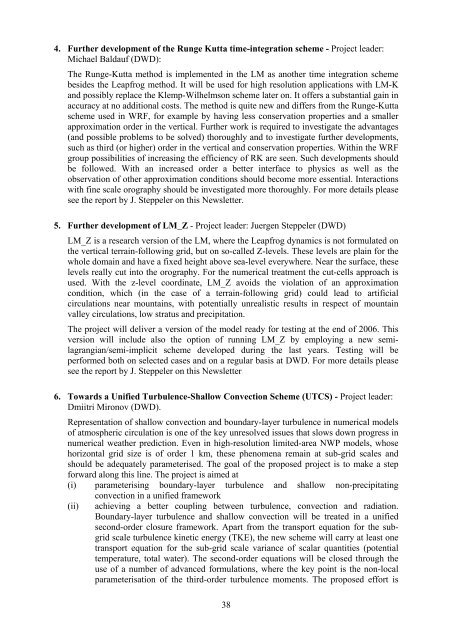Proceedings - C-SRNWP Project
Proceedings - C-SRNWP Project
Proceedings - C-SRNWP Project
You also want an ePaper? Increase the reach of your titles
YUMPU automatically turns print PDFs into web optimized ePapers that Google loves.
4. Further development of the Runge Kutta time-integration scheme - <strong>Project</strong> leader:<br />
Michael Baldauf (DWD):<br />
The Runge-Kutta method is implemented in the LM as another time integration scheme<br />
besides the Leapfrog method. It will be used for high resolution applications with LM-K<br />
and possibly replace the Klemp-Wilhelmson scheme later on. It offers a substantial gain in<br />
accuracy at no additional costs. The method is quite new and differs from the Runge-Kutta<br />
scheme used in WRF, for example by having less conservation properties and a smaller<br />
approximation order in the vertical. Further work is required to investigate the advantages<br />
(and possible problems to be solved) thoroughly and to investigate further developments,<br />
such as third (or higher) order in the vertical and conservation properties. Within the WRF<br />
group possibilities of increasing the efficiency of RK are seen. Such developments should<br />
be followed. With an increased order a better interface to physics as well as the<br />
observation of other approximation conditions should become more essential. Interactions<br />
with fine scale orography should be investigated more thoroughly. For more details please<br />
see the report by J. Steppeler on this Newsletter.<br />
5. Further development of LM_Z - <strong>Project</strong> leader: Juergen Steppeler (DWD)<br />
LM_Z is a research version of the LM, where the Leapfrog dynamics is not formulated on<br />
the vertical terrain-following grid, but on so-called Z-levels. These levels are plain for the<br />
whole domain and have a fixed height above sea-level everywhere. Near the surface, these<br />
levels really cut into the orography. For the numerical treatment the cut-cells approach is<br />
used. With the z-level coordinate, LM_Z avoids the violation of an approximation<br />
condition, which (in the case of a terrain-following grid) could lead to artificial<br />
circulations near mountains, with potentially unrealistic results in respect of mountain<br />
valley circulations, low stratus and precipitation.<br />
The project will deliver a version of the model ready for testing at the end of 2006. This<br />
version will include also the option of running LM_Z by employing a new semilagrangian/semi-implicit<br />
scheme developed during the last years. Testing will be<br />
performed both on selected cases and on a regular basis at DWD. For more details please<br />
see the report by J. Steppeler on this Newsletter<br />
6. Towards a Unified Turbulence-Shallow Convection Scheme (UTCS) - <strong>Project</strong> leader:<br />
Dmiitri Mironov (DWD).<br />
Representation of shallow convection and boundary-layer turbulence in numerical models<br />
of atmospheric circulation is one of the key unresolved issues that slows down progress in<br />
numerical weather prediction. Even in high-resolution limited-area NWP models, whose<br />
horizontal grid size is of order 1 km, these phenomena remain at sub-grid scales and<br />
should be adequately parameterised. The goal of the proposed project is to make a step<br />
forward along this line. The project is aimed at<br />
(i) parameterising boundary-layer turbulence and shallow non-precipitating<br />
convection in a unified framework<br />
(ii) achieving a better coupling between turbulence, convection and radiation.<br />
Boundary-layer turbulence and shallow convection will be treated in a unified<br />
second-order closure framework. Apart from the transport equation for the subgrid<br />
scale turbulence kinetic energy (TKE), the new scheme will carry at least one<br />
transport equation for the sub-grid scale variance of scalar quantities (potential<br />
temperature, total water). The second-order equations will be closed through the<br />
use of a number of advanced formulations, where the key point is the non-local<br />
parameterisation of the third-order turbulence moments. The proposed effort is<br />
38

















